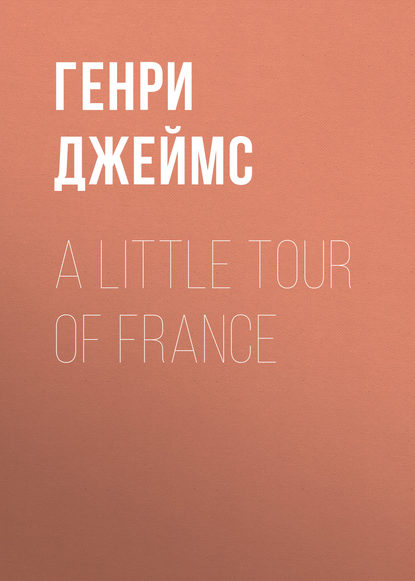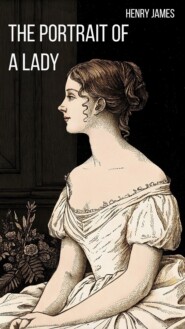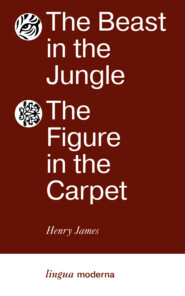По всем вопросам обращайтесь на: info@litportal.ru
(©) 2003-2024.
✖
A Little Tour of France
Настройки чтения
Размер шрифта
Высота строк
Поля
Amboise
YOU may go to Amboise either from Blois or from Tours; it is about half-way between these towns. The great point is to go, especially if you have put it off repeatedly; and to go, if possible, on a day when the great view of the Loire, which you enjoy from the battlements and terraces, presents itself under a friendly sky. Three persons, of whom the author of these lines was one, spent the greater part of a perfect Sunday morning in looking at it. It was astonishing, in the course of the rainiest season in the memory of the oldest Tourangeau, how many perfect days we found to our hand. The town of Amboise lies, like Tours, on the left bank of the river—a little white-faced town staring across an admirable bridge and leaning, behind, as it were, against the pedestal of rock on which the dark castle masses itself. The town is so small, the pedestal so big and the castle so high and striking, that the clustered houses at the base of the rock are like the crumbs that have fallen from a well-laden table. You pass among them, however, to ascend by a circuit to the château, which you attack, obliquely, from behind. It is the property of the Comte de Paris, another pretender to the French throne; having come to him remotely, by inheritance, from his ancestor, the Duc de Penthièvre, who toward the close of the last century bought it from the Crown, which had recovered it after a lapse. Like the castle of Blois, it has been injured and defaced by base uses, but, unlike the castle of Blois, it has not been completely restored. "It is very, very dirty, but very curious"—it is in these terms that I heard it described by an English lady who was generally to be found engaged upon a tattered Tauchnitz in the little salon de lecture of the hotel at Tours. The description is not inaccurate; but it should be said that if part of the dirtiness of Amboise is the result of its having served for years as a barrack and as a prison, part of it comes from the presence of restoring stonemasons, who have woven over a considerable portion of it a mask of scaffolding. There is a good deal of neatness as well, and the restoration of some of the parts seems finished. This process, at Amboise, consists for the most part simply of removing the vulgar excrescences of the last two centuries.
The interior is virtually a blank, the old apartments having been chopped up into small modern rooms; it will have to be completely reconstructed. A worthy woman with a military profile and that sharp, positive manner which the goodwives who show you through the châteaux of Touraine are rather apt to have, and in whose high respectability, to say nothing of the frill of her cap and the cut of her thick brown dress, my companions and I thought we discovered the particular note, or nuance, of Orleanism—a competent, appreciative, peremptory person, I say—attended us through the particularly delightful hour we spent upon the ramparts of Amboise. Denuded and disfeatured within and bristling without with bricklayers' ladders, the place was yet extraordinarily impressive and interesting. I should mention that we spent a great deal of time in looking at the view. Sweet was the view, and magnificent; we preferred it so much to certain portions of the interior, and to occasional effusions of historical information, that the old lady with the profile sometimes lost patience with us. We laid ourselves open to the charge of preferring it even to the little chapel of Saint Hubert, which stands on the edge of the great terrace and has, over the portal, a wonderful sculpture of the miraculous hunt of that holy man. In the way of plastic art this elaborate scene is the gem of Amboise. It seemed to us that we had never been in a place where there are so many points of vantage to look down from. In the matter of position Amboise is certainly supreme in the list of perched places; and I say this with a proper recollection of the claims of Chaumont and of Loches—which latter, by the way (the afterthought is due), is not on the Loire. The platforms, the bastions, the terraces, the high-niched windows and balconies, the hanging gardens and dizzy crenellations, of this complicated structure, keep you in perpetual intercourse with an immense horizon. The great feature of the place is the obligatory round tower which occupies the northern end of it, and which has now been completely restored. It is of astounding size, a fortress in itself, and contains, instead of a staircase, a wonderful inclined plane, so wide and gradual that a coach and four may be driven to the top. This colossal cylinder has to-day no visible use; but it corresponds, happily enough, with the great circle of the prospect. The gardens of Amboise, lifted high aloft, covering the irregular remnants of the platform on which the castle stands and making up in picturesqueness what they lack in extent, constitute of course but a scanty domain. But bathed, as we found them, in the autumn sunshine and doubly private from their aerial site, they offered irresistible opportunities for a stroll interrupted, as one leaned against their low parapets, by long contemplative pauses. I remember in particular a certain terrace planted with clipped limes upon which we looked down from the summit of the big tower. It seemed from that point to be absolutely necessary to one's happiness to go down and spend the rest of the morning there; it was an ideal place to walk to and fro and talk. Our venerable conductress, to whom our relation had gradually become more filial, permitted us to gratify this innocent wish—to the extent, that is, of taking a turn or two under the mossy tilleuls. At the end of this terrace is the low door, in a wall, against the top of which, in 1498, Charles VIII., according to an accepted tradition, knocked his head to such good purpose that he died. It was within the walls of Amboise that his widow, Anne of Brittany, already in mourning for three children, two of whom we have seen commemorated in sepulchral marble at Tours, spent the first violence of that grief which was presently dispelled by a union with her husband's cousin and successor, Louis XII. Amboise was a frequent resort of the French Court during the sixteenth century; it was here that the young Mary Stuart spent sundry hours of her first marriage. The wars of religion have left here the ineffaceable stain which they left wherever they passed. An imaginative visitor at Amboise to-day may fancy that the traces of blood are mixed with the red rust on the crossed iron bars of the grim-looking balcony to which the heads of the Huguenots executed on the discovery of the conspiracy of La Renaudie are rumoured to have been suspended. There was room on the stout balustrade—an admirable piece of work—for a ghastly array. The same rumour represents Catherine de'Medici and the young queen as watching from this balcony the noyades of the captured Huguenots in the Loire. The facts of history are bad enough; the fictions are, if possible, worse; but there is little doubt that the future Queen of Scots learnt the first lessons of life at a horrible school. If in subsequent years she was a prodigy of innocence and virtue, it was not the fault of her whilom mother-in-law, of her uncles of the house of Guise, or of the examples presented to her either at the windows of the castle of Amboise or in its more private recesses.
Chaumont
It was difficult to believe in these dark deeds, however, as we looked through the golden morning at the placidity of the far-shining Loire. The ultimate consequence of this spectacle was a desire to follow the river as far as the castle of Chaumont. It is true that the cruelties practised of old at Amboise might have seemed less phantasmal to persons destined to suffer from a modern form of inhumanity. The mistress of the little inn at the base of the castle-rock—it stands very pleasantly beside the river, and we had breakfasted there—declared to us that the Château de Chaumont, which is often during the autumn closed to visitors, was at that particular moment standing so wide open to receive us that it was our duty to hire one of her carriages and drive thither with speed. This assurance was so satisfactory that we presently found ourselves seated in this wily woman's most commodious vehicle and rolling, neither too fast nor too slow, along the margin of the Loire. The drive of about an hour, beneath constant clumps of chestnuts, was charming enough to have been taken for itself; and indeed when we reached Chaumont we saw that our reward was to be simply the usual reward of virtue, the consciousness of having attempted the right. The Château de Chaumont was inexorably closed; so we learned from a talkative lodge-keeper, who gave what grace she could to her refusal. This good woman's dilemma was almost touching; she wished to reconcile two impossibles. The castle was not to be visited, for the family of its master was staying there; and yet she was loath to turn away a party of which she was good enough to say that it had a grand genre; for, as she also remarked, she had her living to earn. She tried to arrange a compromise, one of the elements of which was that we should descend from our carriage and trudge up a hill which would bring us to a designated point where, over the paling of the garden, we might obtain an oblique and surreptitious view of a small portion of the castle walls. This suggestion led us to inquire (of each other) to what degree of baseness it is lawful for an enlightened lover of the picturesque to resort in order not to have a blank page in his collection. One of our trio decided characteristically against any form of derogation; so she sat in the carriage and sketched some object that was public property while her two companions, who were not so proud, trudged up a muddy ascent which formed a kind of back-stairs. It is perhaps no more than they deserved that they were disappointed. Chaumont is feudal, if you please; but the modern spirit is in possession. It forms a vast clean-scraped mass, with big round towers, ungarnished with a leaf of ivy or a patch of moss, surrounded by gardens of moderate extent (save where the muddy lane of which I speak passes near it), and looking rather like an enormously magnified villa. The great merit of Chaumont is its position, which almost exactly resembles that of Amboise; it sweeps the river up and down and seems to look over half the province. This, however, was better appreciated as, after coming down the hill and re-entering the carriage, we drove across the long suspension-bridge which crosses the Loire just beyond the village and over which we made our way to the small station of Onzain, at the farther end, to take the train back to Tours. Look back from the middle of this bridge; the whole picture composes, as the painters say. The towers, the pinnacles, the fair front of the château, perched above its fringe of garden and the rusty roofs of the village and facing the afternoon sky, which is reflected also in the great stream that sweeps below, all this makes a contribution to your happiest memories of Touraine.
Chapter vii
Chenonceaux
WE never went to Chinon; it was a fatality. We planned it a dozen times; but the weather interfered, or the trains didn't suit, or one of the party was fatigued with the adventures of the day before. This excursion was so much postponed that it was finally postponed to everything. Besides, we had to go to Chenonceaux, to Azay-le-Rideau, to Langeais, to Loches. So I have not the memory of Chinon; I have only the regret. But regret, as well as memory, has its visions; especially when, like memory, it is assisted by photographs. The castle of Chinon in this form appears to me as an enormous ruin, a mediæval fortress of the extent almost of a city. It covers a hill above the Vienne, and after being impregnable in its time is indestructible to-day. (I risk this phrase in the face of the prosaic truth. Chinon, in the days when it was a prize, more than once suffered capture, and at present it is crumbling inch by inch. It is apparent, however, I believe, that these inches encroach little upon acres of masonry.) It was in the castle that Jeanne Dare had her first interview with Charles VII., and it is in the town that François Rabelais is supposed to have been born. To the castle, moreover, the lover of the picturesque is earnestly recommended to direct his steps. But one always misses something, and I would rather have missed Chinon than Chenonceaux. Fortunate exceedingly were the few hours we passed on the spot on which we missed nothing.
"In 1747," says Jean-Jacques Rousseau in his "Confessions," "we went to spend the autumn in Touraine, at the Château of Chenonceaux, a royal residence upon the Cher, built by Henry II. for Diana of Poitiers, whose initials are still to be seen there, and now in possession of M. Dupin, the farmer-general. We amused ourselves greatly at this fine place; the living was of the best, and I became as fat as a monk. We made a great deal of music and acted comedies."
This is the only description that Rousseau gives of one of the most romantic houses in France and of an episode that must have counted as one of the most agreeable in his uncomfortable career. The eighteenth century contented itself with general epithets; and when Jean-Jacques has said that Chenonceaux was a "beau lieu," he thinks himself absolved from further characterisation. We later sons of time have, both for our pleasure and our pain, invented the fashion of special terms, and I am afraid that even common decency obliges me to pay some larger tribute than this to the architectural gem of Touraine. Fortunately I can discharge my debt with gratitude. In going from Tours you leave the valley of the Loire and enter that of the Cher, and at the end of about an hour you see the turrets of the castle on your right, among the trees, down in the meadows, beside the quiet little river. The station and the village are about ten minutes' walk from the château, and the village contains a very tidy inn, where, if you are not in too great a hurry to commune with the shades of the royal favourite and the jealous queen, you will perhaps stop and order a dinner to be ready for you in the evening. A straight, tall avenue leads to the grounds of the castle; what I owe to exactitude compels me to add that it is crossed by the railway-line. The place is so arranged, however, that the château need know nothing of passing trains—which pass, indeed, though the grounds are not large, at a very sufficient distance. I may add that the trains throughout this part of France have a noiseless, desultory, dawdling, almost stationary quality, which makes them less of an offence than usual. It was a Sunday afternoon and the light was yellow save under the trees of the avenue, where, in spite of the waning of September, it was duskily green. Three or four peasants, in festal attire, were strolling about. On a bench at the beginning of the avenue sat a man with two women. As I advanced with my companions he rose, after a sudden stare, and approached me with a smile in which (to be Johnsonian for a moment) certitude was mitigated by modesty and eagerness was embellished with respect. He came toward me with a salutation that I had seen before, and I am happy to say that after an instant I ceased to be guilty of the brutality of not knowing where. There was only one place in the world where people smile like that, only one place where the art of salutation has that perfect grace. This excellent creature used to crook his arm, in Venice, when I stepped into my gondola; and I now laid my hand on that member with the familiarity of glad recognition; for it was only surprise that had kept me even for a moment from accepting the genial Francesco as an ornament of the landscape of Touraine. What on earth—the phrase is the right one—was a Venetian gondolier doing at Chenonceaux? He had been brought from Venice, gondola and all, by the mistress of the charming house, to paddle about on the Cher. Our meeting was affectionate, though there was a kind of violence in seeing him so far from home. He was too well dressed, too well fed; he had grown stout, and his nose had the tinge of good claret. He remarked that the life of the household to which he had the honour to belong was that of a casa regia; which must have been a great change for poor Checco, whose habits in Venice were not regal. However, he was the sympathetic Checco still; and for five minutes after I left him I thought less about the little pleasure-house by the Cher than about the palaces of the Adriatic.
But attention was not long in coming round to the charming structure that presently rose before us. The pale yellow front of the château, the small scale of which is at first a surprise, rises beyond a considerable court, at the entrance of which a massive and detached round tower, with a turret on its brow (a relic of the building that preceded the actual villa), appears to keep guard. This court is not enclosed—or is enclosed at least only by the gardens, portions of which are at present in process of radical readjustment. Therefore, though Chenonceaux has no great height, its delicate façade stands up boldly enough. This façade, one of the most finished things in Touraine, consists of two storeys, surmounted by an attic which, as so often in the buildings of the French Renaissance, is the richest part of the house. The high-pitched roof contains three windows of beautiful design, covered with embroidered caps and flowering into crocketed spires. The window above the door is deeply niched; it opens upon a balcony made in the form of a double pulpit—one of the most charming features of the front. Chenonceaux is not large, as I say, but into its delicate compass is packed a great deal of history—history which differs from that of Amboise and Blois in being of the private and sentimental kind. The echoes of the place, faint and far as they are to-day, are not political, but personal. Chenonceaux dates, as a residence, from the year 1515, when the shrewd Thomas Bohier, a public functionary who had grown rich in handling the finances of Normandy and had acquired the estate from a family which, after giving it many feudal lords, had fallen into poverty, erected the present structure on the foundations of an old mill. The design is attributed, with I know not what justice, to Pierre Nepveu, alias Trinqueau, the audacious architect of Chambord. On the death of Bohier the house passed to his son, who, however, was forced, under cruel pressure, to surrender it to the Crown in compensation for a so-called deficit in the official accounts of this rash parent and predecessor. Francis I. held the place till his death; but Henry II., on ascending the throne, presented it out of hand to that mature charmer, the admired of two generations, Diana of Poitiers. Diana enjoyed it till the death of her protector; but when this event occurred the widow of the monarch, who had been obliged to submit in silence, for years, to the ascendency of a rival, took the most pardonable of all the revenges with which the name of Catherine de'Medici is associated and turned her out of doors. Diana was not in want of refuges, Catherine went through the form of giving her Chaumont in exchange; but there was only one Chenonceaux. Catherine devoted herself to making the place more completely unique. The feature that renders it sole of its kind is not appreciated till you wander round to either side of the house. If a certain springing lightness is the characteristic of Chenonceaux, if it bears in every line the aspect of a place of recreation—a place intended for delicate, chosen pleasures—nothing can confirm this expression better than the strange, unexpected movement with which, from behind, it carries itself across the river. The earlier building stands in the water; it had inherited the foundations of the mill destroyed by Thomas Bohier. The first step therefore had been taken upon solid piles of masonry; and the ingenious Catherine—she was a raffinée—simply proceeded to take the others. She continued the piles to the opposite bank of the Cher, and over them she threw a long, straight gallery of two tiers. This part of the château, which mainly resembles a house built upon a bridge and occupying its entire length, is of course the great curiosity of Chenonceaux. It forms on each floor a charming corridor, which, within, is illuminated from either side by the flickering river-light. The architecture of these galleries, seen from without, is less elegant than that of the main building, but the aspect of the whole thing is delightful. I have spoken of Chenonceaux as a "villa," using the word advisedly, for the place is neither a castle nor a palace. It is a very exceptional villa, but it has the villa-quality—the look of being intended for life in common. This look is not at all contradicted by the wing across the Cher, which only suggests indoor perspectives and intimate pleasures—walks in pairs on rainy days; games and dances on autumn nights; together with as much as may be of moonlighted dialogue (or silence) in the course of evenings more genial still, in the well-marked recesses of windows.
It Chenonceaux is safe to say that such things took place there in the last century, during the kindly reign of Monsieur and Madame Dupin. This period presents itself as the happiest in the annals of Chenonceaux. I know not what festive train the great Diana may have led, and my imagination, I am afraid, is only feebly kindled by the records of the luxurious pastimes organised on the banks of the Cher by that terrible daughter of the Medici whose appreciation of the good things of life was perfectly consistent with a failure to perceive why others should live to enjoy them. The best society that ever assembled there was collected at Chenonceaux during the middle of the eighteenth century. This was surely, in France at least, the age of good society, the period when the "right people" made every haste to be born in time. Such people must of course have belonged to the fortunate few—not to the miserable many; for if a society be large enough to be good, it must also be small enough. The sixty years that preceded the Revolution were the golden age of fireside talk and of those amenities that proceed from the presence of women in whom the social art is both instinctive and acquired. The women of that period were, above all, good company; the fact is attested in a thousand documents. Chenonceaux offered a perfect setting to free conversation; and infinite joyous discourse must have mingled with the liquid murmur of the Cher. Claude Dupin was not only a great man of business, but a man of honour and a patron of knowledge; and his wife was gracious, clever, and wise. They had acquired this famous property by purchase (from one of the Bourbons, as Chenonceaux, for two centuries after the death of Catherine de'Medici, remained constantly in princely hands), and it was transmitted to their son, Dupin de Francueil, grandfather of Madame George Sand. This lady, in her Correspondence, lately published, describes a visit that she paid more than thirty years ago to those members of her family who were still in possession. The owner of Chenonceaux to-day[1 - 1884.] is the daughter of an Englishman naturalised in France. But I have wandered far from my story, which is simply a sketch of the surface of the place. Seen obliquely, from either side, in combination with its bridge and gallery, the structure is singular and fantastic, a striking example of a wilful and capricious conception. Unfortunately all caprices are not so graceful and successful, and I grudge the honour of this one to the false and blood-polluted Catherine. (To be exact, I believe the arches of the bridge were laid by the elderly Diana. It was Catherine, however, who completed the monument.) Within, the house has been, as usual, restored. The staircases and ceilings, in all the old royal residences of this part of France, are the parts that have suffered least; many of them have still much of the life of the old time about them. Some of the chambers of Chenonceaux, however, encumbered as they are with modern detail, derive a sufficiently haunted and suggestive look from the deep setting of their beautiful windows, which thickens the shadows and makes dark corners. There is a charming little Gothic chapel, with its apse hanging over the water, fastened to the left flank of the house. Some of the upper balconies, which look along the outer face of the gallery and either up or down the river, are delightful protected nooks. We walked through the lower gallery to the other bank of the Cher; this fine apartment appeared to be for the moment a purgatory of ancient furniture. It terminates rather abruptly; it simply stops, with a blank wall. There ought, of course, to have been a pavilion here, though I prefer very much the old defect to any modern remedy. The wall is not so blank, however, but that it contains a door which opens on a rusty drawbridge. This drawbridge traverses the small gap which divides the end of the gallery from the bank of the stream. The house, therefore, does not literally rest on opposite edges of the Cher, but rests on one and just fails to rest on the other. The pavilion would have made that up; but after a moment we ceased to miss this imaginary feature. We passed the little drawbridge, and wandered awhile beside the river. From this opposite bank the mass of the château looked more charming than ever; and the little peaceful, lazy Cher, where two or three men were fishing in the eventide, flowed under the clear arches and between the solid pedestals of the part that spanned it, with the softest, vaguest light on its bosom. This was the right perspective; we were looking across the river of time. The whole scene was deliciously mild. The moon came up; we passed back through the gallery and strolled about a little longer in the gardens. It was very still. I met my old gondolier in the twilight. He showed me his gondola, but I hated, somehow, to see it there. I don't like, as the French say, to mêler les genres

















